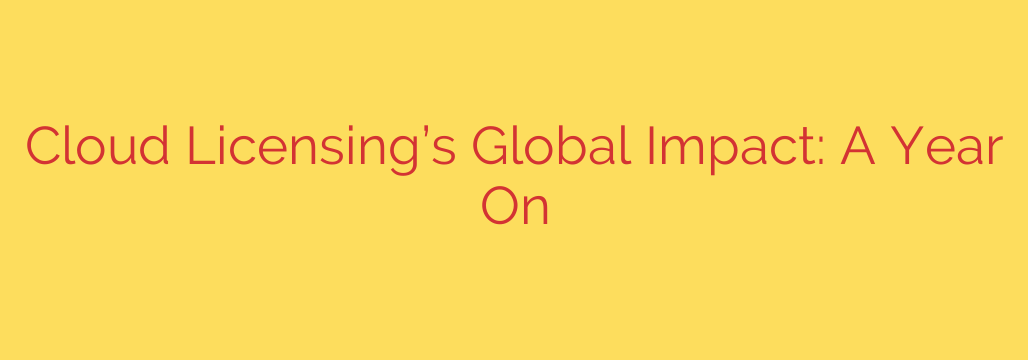
The State of Cloud Licensing: A Global Look at Today’s Trends and Tomorrow’s Challenges
The way we access and manage software has fundamentally changed. Gone are the days of physical discs and complex on-premise license keys. Today, the industry is dominated by a more flexible, scalable, and globally accessible model: cloud licensing. This shift isn’t just a fleeting trend; it represents a new standard for software deployment and management.
As businesses continue their digital transformation journeys, understanding the nuances of cloud licensing is no longer optional—it’s essential for security, growth, and a competitive edge. Let’s explore the key global trends, pressing challenges, and the future of this transformative technology.
Why Cloud Licensing Has Become the New Standard
At its core, cloud licensing delivers software licenses to users over the internet, managing access and usage rights from a central server. This model has exploded in popularity for several compelling reasons.
First and foremost, it offers unparalleled flexibility and scalability. Businesses can instantly scale their license count up or down based on real-time demand, avoiding the costs of over-provisioning or the limitations of under-licensing. This agility is crucial in today’s fast-paced market.
Second, it provides centralized management and control. Administrators can monitor usage, manage entitlements, and deploy updates from a single dashboard, regardless of where their users are located. This simplifies IT overhead and ensures everyone is working with the latest, most secure version of the software.
Finally, it enhances accessibility and user experience. Users can access their software from any device, anywhere in the world, fostering productivity for remote and hybrid teams. The subscription-based model also shifts capital expenditure (CapEx) to a more predictable operating expenditure (OpEx).
Key Global Trends Shaping the Landscape
The cloud licensing environment is constantly evolving. A few dominant trends have emerged over the past year, defining how businesses approach software deployment.
- The Unstoppable Shift to Subscription Models: The “as-a-service” economy is in full swing. Companies across all sectors are moving away from perpetual licenses in favor of subscription-based Software as a Service (SaaS) offerings. This provides predictable revenue for vendors and predictable costs for customers.
- The Rise of Hybrid Models: While pure cloud is popular, many organizations, especially in manufacturing and engineering, still rely on on-premise systems for security or performance reasons. Hybrid licensing models have become the go-to solution, allowing businesses to blend cloud-based flexibility with the control of on-premise deployment. This “best of both worlds” approach is gaining significant traction globally.
- A Laser Focus on Data and Security: With increased cloud adoption comes a heightened awareness of security vulnerabilities. Cybersecurity is no longer an afterthought; it’s a primary consideration. Vendors are embedding advanced security features directly into their licensing platforms, including threat detection, identity management, and robust encryption to protect intellectual property and user data.
Navigating the Modern Challenges of Cloud Licensing
Despite its many benefits, the move to the cloud is not without its hurdles. Successfully navigating this landscape requires a proactive approach to several key challenges.
Security and Compliance: Managing licenses in the cloud means entrusting a third-party vendor with critical data. This raises significant concerns about data privacy and compliance with regulations like GDPR and CCPA. Businesses must conduct thorough due diligence on a vendor’s security posture and ensure their data residency and protection policies align with legal requirements.
Cost Management and Optimization: The ease of spinning up new services can lead to “cloud sprawl” and unexpected costs. Without proper oversight, subscription fees can quickly accumulate. Effective cost management requires continuous monitoring of usage, identifying underutilized licenses, and optimizing subscription tiers to avoid unnecessary spending.
Vendor Lock-In: Migrating from one cloud provider to another can be complex and expensive. This risk of vendor lock-in means that choosing the right partner from the start is critical. Businesses should look for providers who use open standards and offer clear data export policies to maintain long-term flexibility.
Actionable Security Tips for Your Business
Protecting your software assets in the cloud is a shared responsibility. Here are essential steps your organization can take to enhance security:
- Implement a Zero-Trust Security Model: Assume no user or device is inherently trustworthy. Enforce strict identity verification and multi-factor authentication (MFA) for all users attempting to access licensed software.
- Regularly Audit and Monitor Usage: Use the analytics provided by your licensing platform to monitor for unusual activity. Look for signs of unauthorized access, such as logins from unexpected geographic locations or an unusual number of activation requests.
- Vet Your Vendor’s Security Protocols: Before signing a contract, ask potential vendors detailed questions about their security infrastructure, encryption standards, incident response plans, and compliance certifications (e.g., ISO 27001, SOC 2).
- Educate Your Team: Human error remains a leading cause of security breaches. Train your employees on best practices for password hygiene, recognizing phishing attempts, and understanding their role in protecting the company’s digital assets.
The Future is Smart and Secure
Looking ahead, the evolution of cloud licensing will be driven by automation and intelligence. We can expect to see more AI-powered analytics that provide deep insights into usage patterns, helping businesses optimize costs and predict future needs. Automation will streamline license provisioning and compliance checks, freeing up IT teams to focus on more strategic initiatives.
Ultimately, cloud licensing is more than just a delivery mechanism; it’s a strategic enabler for modern business. By embracing its flexibility while diligently managing its security and cost challenges, organizations can unlock new levels of efficiency and innovation on a global scale.
Source: https://cloud.google.com/blog/topics/inside-google-cloud/global-harms-restrictive-cloud-licensing-one-year-later/








